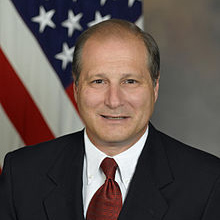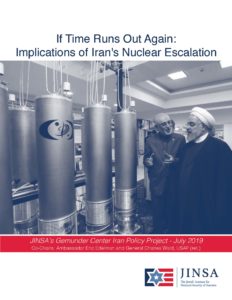If Time Runs Out Again: Implications of Iran’s Nuclear Escalation
In light of Iran’s recent decisions to violate the Joint Comprehensive Plan of Action (JCPOA), the Gemunder Center’s Iran Policy Project issues a new report assessing the potential effects of these decisions on Iran’s progress toward nuclear weapons capability, as well as the impact of further escalatory steps Iran could take toward a bomb.
Featuring:
Amb. Eric Edelman, JINSA Iran Policy Project Co-Chair
and
Jonathan Ruhe, Associate Director of JINSA’s Gemunder Center
moderated by:
Michael Makovsky, PhD, JINSA President & CEO
 |
 |
 |
|---|
Tuesday, July 9
3:30pm (EDT)
Please note: Members of the press will receive priority during the question and answer session.
Report Overview
Time may again start running out to address the Iranian nuclear problem. In response to the U.S. withdrawal from the Joint Comprehensive Plan of Action (JCPOA) last year, Tehran declared on May 8 it would soon exceed the deal’s caps on uranium and heavy water stockpiles, with further violations beginning July 7 and every sixty days thereafter, unless the remaining parties offset U.S. sanctions. On Sunday, Tehran announced it would start enriching uranium to higher purity than the deal permits.
These steps could begin reducing the “breakout time” Iran needs to produce enough fissile material for a nuclear weapon. They not only demonstrate just how reversible the JCPOA’s constraints are, but also indicate where Iran could apply additional pressure by moving even closer to nuclear weapons capability – most effectively and worryingly by expanding its uranium enrichment capacity.
By itself, Iran’s decision to grow its 3.67 percent low enriched uranium (LEU) stockpile could shrink breakout time steadily and significantly, but not precipitously. Breakout time will shrink more rapidly as Iran also fulfills its July 7 threat to enrich beyond 3.67 percent LEU, to the point where inspectors might struggle to detect a breakout attempt less than a year from now if Iran enriches near-20 percent LEU. Similarly, growing its heavy water stockpile will not advance its ability to produce a nuclear weapon via plutonium, unless it also fulfills its threat to revert to the pre-JCPOA design for its heavy water reactor at Arak.
Looking ahead, Iran could cut its breakout time immediately and markedly by expanding its uranium enrichment capacity – most likely and feasibly by reinstalling centrifuges removed under the JCPOA and restarting uranium enrichment at its deeply-buried Fordow facility.
Given its track record of undeclared nuclear facilities, the possibility that Iran also is currently, or would start, engaging in covert activities cannot be ignored. Nor can the possibility of Iran ending its adherence to international safeguards designed to detect and report on its nuclear activities. As its leading officials have threatened, Iran could even leave the JCPOA and potentially the Non-Proliferation Treaty (NPT) altogether.
As Iran takes its preparatory steps, the United States should take its own steps to prevent any potential Iranian breakout. American policymakers should make clear they will use whatever tools necessary to prevent Tehran achieving undetectable breakout capability. American policymakers should underscore this redline through viable contingency plans to neutralize Iran’s nuclear facilities and nuclear-capable missiles, increased forward military posture, coordination with regional allies to defend against Iranian retaliation and public declarations and joint exercises to make U.S. intentions and capabilities abundantly clear to Tehran.
